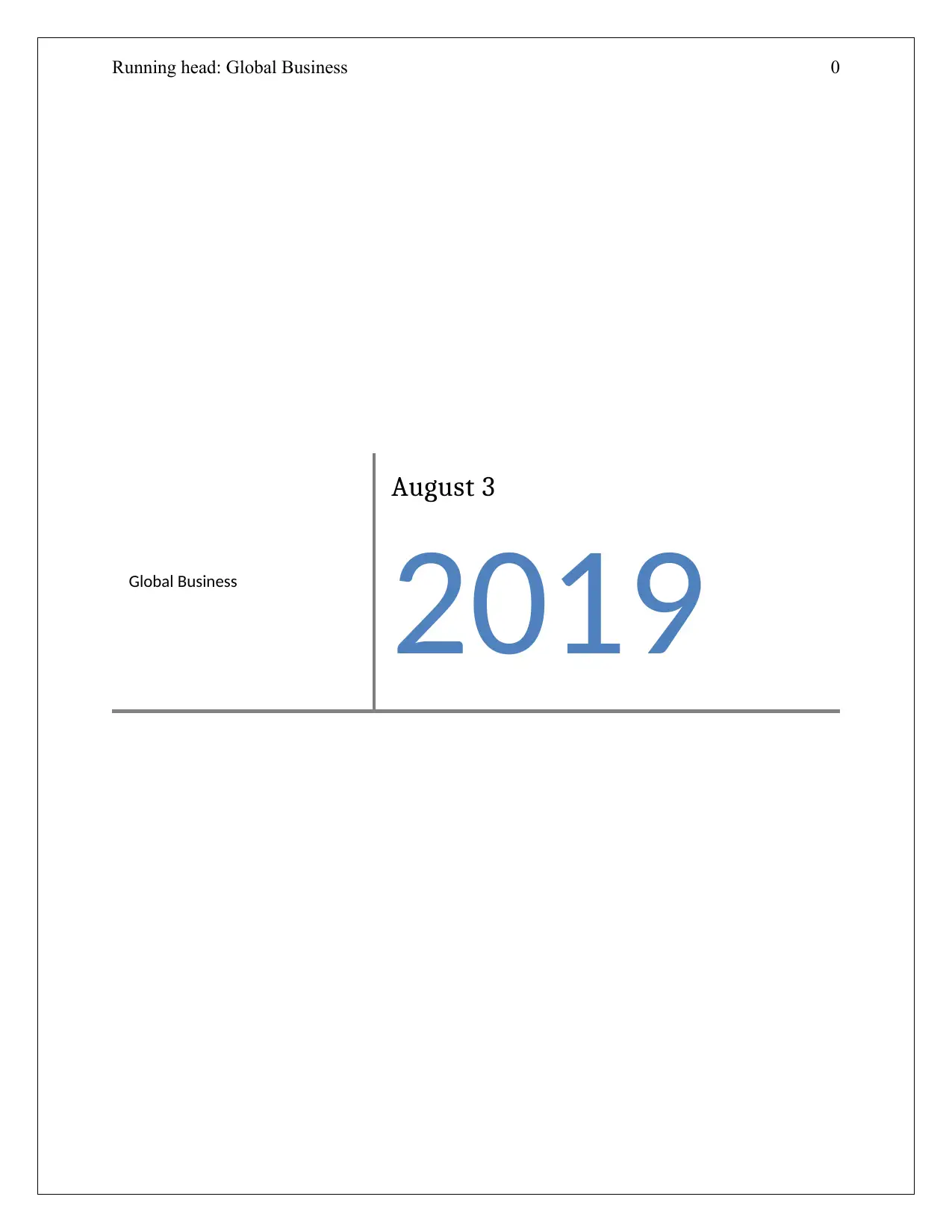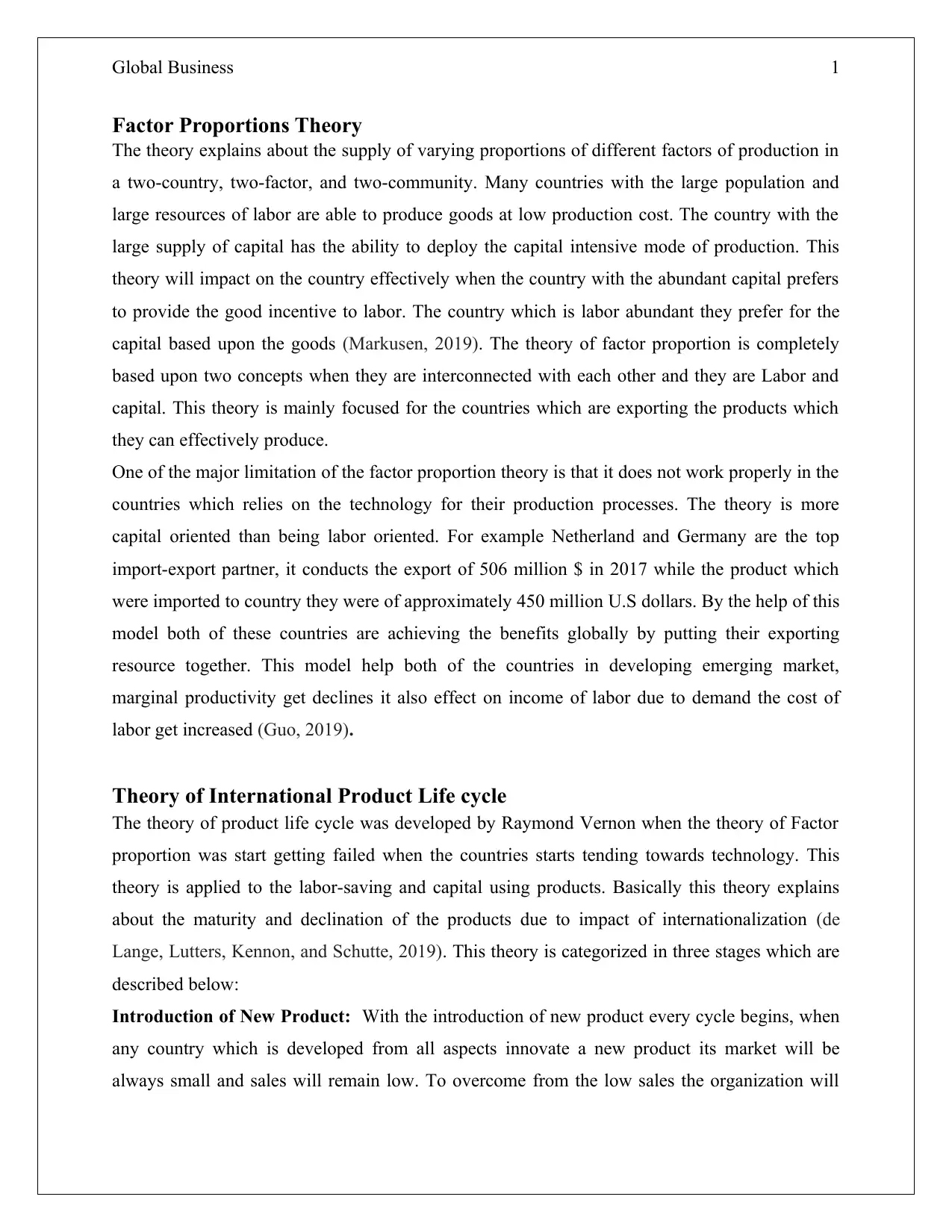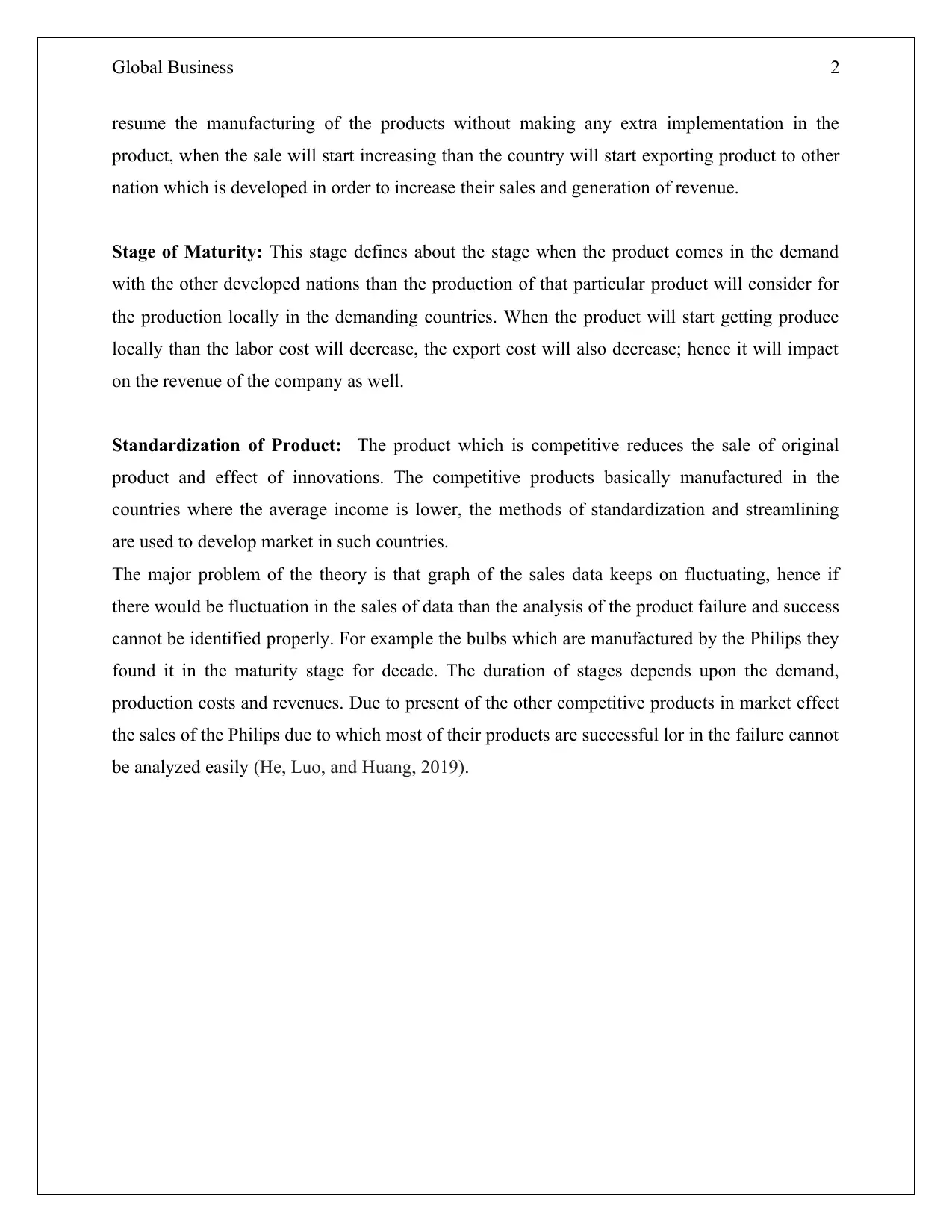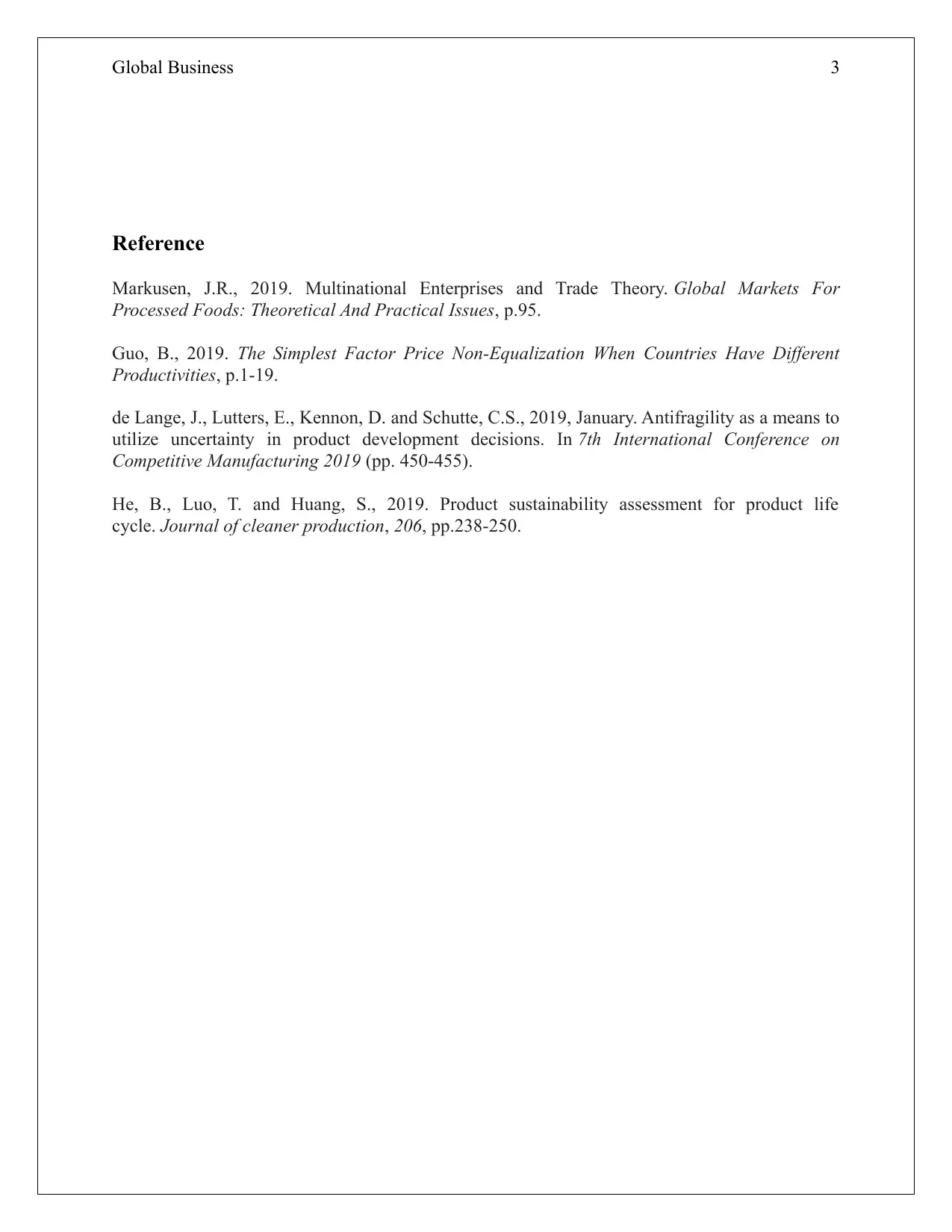Global Business Theories, Globalization, and Trade Analysis Report
VerifiedAdded on 2022/10/11
|4
|863
|16
Report
AI Summary
This report addresses key concepts in global business, as per the MNG00723 assignment. It begins by defining globalization and analyzing its positive and negative impacts on domestic businesses. The report then explains the Factor Proportions Theory and the International Product Cycle Theory, including their limitations and real-world examples. Finally, it examines the rationale and implications of tariffs imposed on Chinese imports, based on the theories discussed. The analysis incorporates at least five academic sources to support the viewpoints and provides a comprehensive overview of the topics covered in the assignment, offering valuable insights into global business dynamics and trade policies.

Running head: Global Business 0
Global Business
August 3
2019
Global Business
August 3
2019
Paraphrase This Document
Need a fresh take? Get an instant paraphrase of this document with our AI Paraphraser

Global Business 1
Factor Proportions Theory
The theory explains about the supply of varying proportions of different factors of production in
a two-country, two-factor, and two-community. Many countries with the large population and
large resources of labor are able to produce goods at low production cost. The country with the
large supply of capital has the ability to deploy the capital intensive mode of production. This
theory will impact on the country effectively when the country with the abundant capital prefers
to provide the good incentive to labor. The country which is labor abundant they prefer for the
capital based upon the goods (Markusen, 2019). The theory of factor proportion is completely
based upon two concepts when they are interconnected with each other and they are Labor and
capital. This theory is mainly focused for the countries which are exporting the products which
they can effectively produce.
One of the major limitation of the factor proportion theory is that it does not work properly in the
countries which relies on the technology for their production processes. The theory is more
capital oriented than being labor oriented. For example Netherland and Germany are the top
import-export partner, it conducts the export of 506 million $ in 2017 while the product which
were imported to country they were of approximately 450 million U.S dollars. By the help of this
model both of these countries are achieving the benefits globally by putting their exporting
resource together. This model help both of the countries in developing emerging market,
marginal productivity get declines it also effect on income of labor due to demand the cost of
labor get increased (Guo, 2019).
Theory of International Product Life cycle
The theory of product life cycle was developed by Raymond Vernon when the theory of Factor
proportion was start getting failed when the countries starts tending towards technology. This
theory is applied to the labor-saving and capital using products. Basically this theory explains
about the maturity and declination of the products due to impact of internationalization (de
Lange, Lutters, Kennon, and Schutte, 2019). This theory is categorized in three stages which are
described below:
Introduction of New Product: With the introduction of new product every cycle begins, when
any country which is developed from all aspects innovate a new product its market will be
always small and sales will remain low. To overcome from the low sales the organization will
Factor Proportions Theory
The theory explains about the supply of varying proportions of different factors of production in
a two-country, two-factor, and two-community. Many countries with the large population and
large resources of labor are able to produce goods at low production cost. The country with the
large supply of capital has the ability to deploy the capital intensive mode of production. This
theory will impact on the country effectively when the country with the abundant capital prefers
to provide the good incentive to labor. The country which is labor abundant they prefer for the
capital based upon the goods (Markusen, 2019). The theory of factor proportion is completely
based upon two concepts when they are interconnected with each other and they are Labor and
capital. This theory is mainly focused for the countries which are exporting the products which
they can effectively produce.
One of the major limitation of the factor proportion theory is that it does not work properly in the
countries which relies on the technology for their production processes. The theory is more
capital oriented than being labor oriented. For example Netherland and Germany are the top
import-export partner, it conducts the export of 506 million $ in 2017 while the product which
were imported to country they were of approximately 450 million U.S dollars. By the help of this
model both of these countries are achieving the benefits globally by putting their exporting
resource together. This model help both of the countries in developing emerging market,
marginal productivity get declines it also effect on income of labor due to demand the cost of
labor get increased (Guo, 2019).
Theory of International Product Life cycle
The theory of product life cycle was developed by Raymond Vernon when the theory of Factor
proportion was start getting failed when the countries starts tending towards technology. This
theory is applied to the labor-saving and capital using products. Basically this theory explains
about the maturity and declination of the products due to impact of internationalization (de
Lange, Lutters, Kennon, and Schutte, 2019). This theory is categorized in three stages which are
described below:
Introduction of New Product: With the introduction of new product every cycle begins, when
any country which is developed from all aspects innovate a new product its market will be
always small and sales will remain low. To overcome from the low sales the organization will

Global Business 2
resume the manufacturing of the products without making any extra implementation in the
product, when the sale will start increasing than the country will start exporting product to other
nation which is developed in order to increase their sales and generation of revenue.
Stage of Maturity: This stage defines about the stage when the product comes in the demand
with the other developed nations than the production of that particular product will consider for
the production locally in the demanding countries. When the product will start getting produce
locally than the labor cost will decrease, the export cost will also decrease; hence it will impact
on the revenue of the company as well.
Standardization of Product: The product which is competitive reduces the sale of original
product and effect of innovations. The competitive products basically manufactured in the
countries where the average income is lower, the methods of standardization and streamlining
are used to develop market in such countries.
The major problem of the theory is that graph of the sales data keeps on fluctuating, hence if
there would be fluctuation in the sales of data than the analysis of the product failure and success
cannot be identified properly. For example the bulbs which are manufactured by the Philips they
found it in the maturity stage for decade. The duration of stages depends upon the demand,
production costs and revenues. Due to present of the other competitive products in market effect
the sales of the Philips due to which most of their products are successful lor in the failure cannot
be analyzed easily (He, Luo, and Huang, 2019).
resume the manufacturing of the products without making any extra implementation in the
product, when the sale will start increasing than the country will start exporting product to other
nation which is developed in order to increase their sales and generation of revenue.
Stage of Maturity: This stage defines about the stage when the product comes in the demand
with the other developed nations than the production of that particular product will consider for
the production locally in the demanding countries. When the product will start getting produce
locally than the labor cost will decrease, the export cost will also decrease; hence it will impact
on the revenue of the company as well.
Standardization of Product: The product which is competitive reduces the sale of original
product and effect of innovations. The competitive products basically manufactured in the
countries where the average income is lower, the methods of standardization and streamlining
are used to develop market in such countries.
The major problem of the theory is that graph of the sales data keeps on fluctuating, hence if
there would be fluctuation in the sales of data than the analysis of the product failure and success
cannot be identified properly. For example the bulbs which are manufactured by the Philips they
found it in the maturity stage for decade. The duration of stages depends upon the demand,
production costs and revenues. Due to present of the other competitive products in market effect
the sales of the Philips due to which most of their products are successful lor in the failure cannot
be analyzed easily (He, Luo, and Huang, 2019).
⊘ This is a preview!⊘
Do you want full access?
Subscribe today to unlock all pages.

Trusted by 1+ million students worldwide

Global Business 3
Reference
Markusen, J.R., 2019. Multinational Enterprises and Trade Theory. Global Markets For
Processed Foods: Theoretical And Practical Issues, p.95.
Guo, B., 2019. The Simplest Factor Price Non-Equalization When Countries Have Different
Productivities, p.1-19.
de Lange, J., Lutters, E., Kennon, D. and Schutte, C.S., 2019, January. Antifragility as a means to
utilize uncertainty in product development decisions. In 7th International Conference on
Competitive Manufacturing 2019 (pp. 450-455).
He, B., Luo, T. and Huang, S., 2019. Product sustainability assessment for product life
cycle. Journal of cleaner production, 206, pp.238-250.
Reference
Markusen, J.R., 2019. Multinational Enterprises and Trade Theory. Global Markets For
Processed Foods: Theoretical And Practical Issues, p.95.
Guo, B., 2019. The Simplest Factor Price Non-Equalization When Countries Have Different
Productivities, p.1-19.
de Lange, J., Lutters, E., Kennon, D. and Schutte, C.S., 2019, January. Antifragility as a means to
utilize uncertainty in product development decisions. In 7th International Conference on
Competitive Manufacturing 2019 (pp. 450-455).
He, B., Luo, T. and Huang, S., 2019. Product sustainability assessment for product life
cycle. Journal of cleaner production, 206, pp.238-250.
1 out of 4
Related Documents
Your All-in-One AI-Powered Toolkit for Academic Success.
+13062052269
info@desklib.com
Available 24*7 on WhatsApp / Email
![[object Object]](/_next/static/media/star-bottom.7253800d.svg)
Unlock your academic potential
Copyright © 2020–2025 A2Z Services. All Rights Reserved. Developed and managed by ZUCOL.




